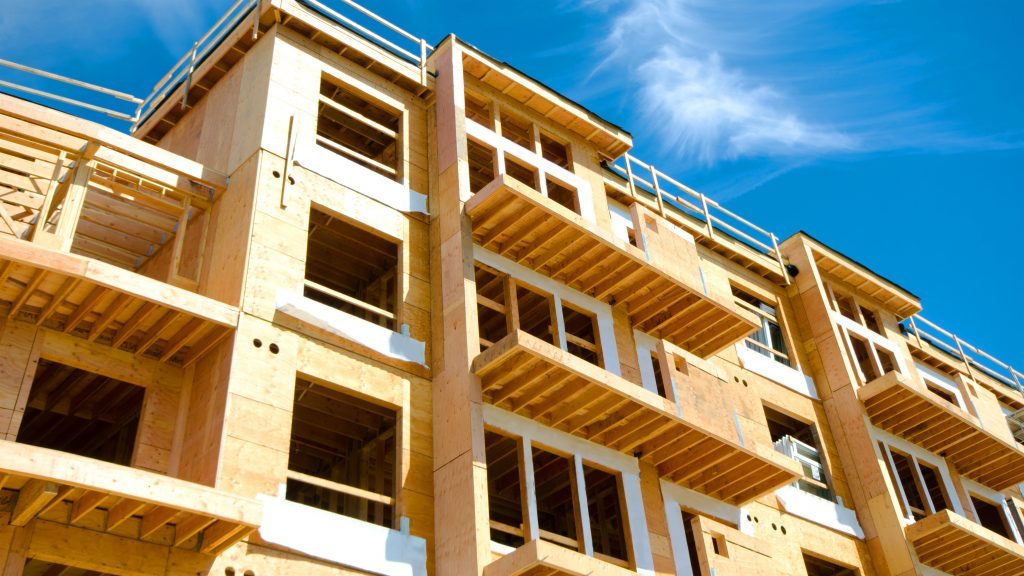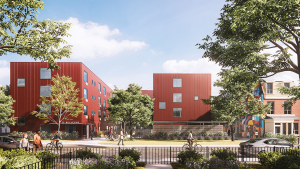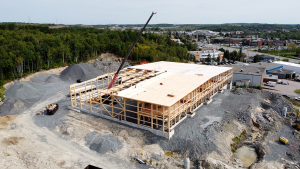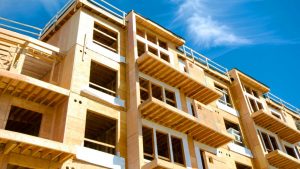Current supply chain difficulties that extend lead times on commodities such as steel I-joists and pre-engineered building are creating new opportunities for mass timber products in the construction of lowrise commercial buildings across Canada.
So says Patrick Crabbe, national director of mass timber with Bird Construction, pointing out mass timber beams and columns can make a leap into the one-storey, 10,000 to 15,000 square foot office-retail building world because they can be manufactured in only eight weeks and installed in another two.
Developers have often used pre-engineered steel designs for the lowrise structures because of budget and construction time familiarity but since the pandemic lead times on materials have thrown a wrinkle into schedules. Pre-engineered buildings can take 32 weeks or longer for delivery, forcing developers to re-evaluate alternatives.
Prior to the pandemic, Bird could deliver a multi-tenant, 10,000-square-foot bricks and mortar project in six to eight months, says Crabbe.
“Now, it takes like 16 months. Over the past eight months it has been steel components that are creating the scheduled delays.”
He says while steel prices are rising, lumber costs have dropped “substantially” since spring.
“The reality of the supply chain dynamics is that COVID-19 and the construction increase of large distribution centres (Amazon and Walmart are examples) have created a lack of supply of commodity items like steel I-joists or pre-engineered buildings.”
Crabbe, who oversees everything from pre-construction to execution for all of Bird’s mass timber projects in Canada, says according to the Canadian Wood Council (CWC), lowrise commercial is the largest construction sector in Canada, representing about 40 per cent of non-residential, but it uses the lowest board foot per square foot.
While mass timber might cost a bit more than steel, delays in delivery and lead time of I-joists has brought up the end costs of buildings constructed in steel.
Crabbe expects mass timber to grow in the “hybrid industrial office” sector, even when steel supply returns to normal, because “people are going to want to be in these higher quality spaces” and the buildings will generate more revenue for owners.
What’s more, mass timber has environmental and carbon sequestration benefits over steel and concrete.
“To meet the infrastructure pressures of society, this is a solution without the environmental detriment.”
In past years most contractors were unfamiliar with mass timber. Today many are ready to bid because they understand the procurement and delivery, he adds.
While the lowrise commercial sector is sizable, Bird’s mass timber expert is confident in the immediate term Canadian mass timber manufacturers have the production capacity to meet the demand because of recent expansion efforts.
He says the CWC is preparing to publish a lowrise commercial construction guide highlighting cost-effective mass timber solutions.
Bird Construction has a portfolio of 25 mass timber projects worth $1.1 billion.
Crabbe says the scale of the projects over the past two or three years has “increased substantially,” driven by the approval of 12-storey mass timber structures in the 2020 National Building Code, which has been adopted by a few provinces, including Quebec and B.C. More provinces will follow pointing to a promising future for the sector.
“That coupled with the International Building Code being 12 to 18 months away from accepting 21 storeys of mass timber, I think it is safe to say that in the next 18 to 24 months there could be some supply challenges, if interest rates and financial markets remain stable and if mass timber production capacities remain the same.”










Recent Comments
comments for this post are closed